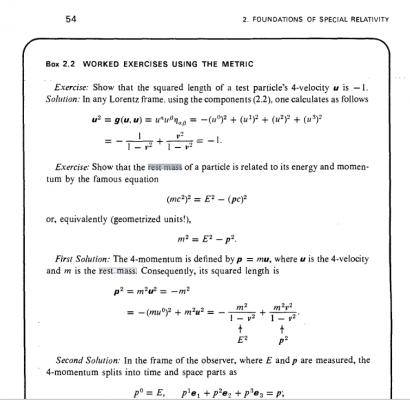-
Posts
720 -
Joined
-
Last visited
Content Type
Profiles
Forums
Events
Everything posted by juanrga
-
Photons have zero mass. Light behaves as radiation, which is different from matter.
-
The minimal quantum of energy is zero.
-

How do i get professional feedback on theories?
juanrga replied to too-open-minded's topic in Science Education
Occasionally I get a pair of emails with someone (not a scientist) trying to explain me their revolutionary 'theory'. I do not doubt of their sincere attempt to help scientists to develop science, but they do not understand science because they never studied it! As ajb said, you know their level of knowledge after reading a pair of paragraphs. Most of them do not understand that science is an accumulative endeavour, with new theories complementing or extending previous theories. When someone email you saying that relativity is wrong or quantum mechanics is wrong, you know that this person does not know the most basic aspects of science. Each new theory may explain new phenomena, but also be in complete concordance with previous phenomena already explained by the old theories. This is the reason which you may study first what is known, before you try to improve/extend what we already know. You say that you are impatient. Do you know the average age of current Nobel winners? Today, science is hard and very extense. You need many years of study before becoming an expert in a narrow field and you need many more years (and large doses of good luck) before you make an important contribution to a narrow field. When someone is emailed with a supposed revolutionary idea/hypothesis, but the email reflects a lack of understanding of basic aspects in the field, the receptor of the email receives more or less the next hidden message: -
The OP wrote "What's the units they use(cm or m) when we derive the Boltzmann constant?". I tried to clarify that the constant kB is the same using centimetres or metres (details below). A universal constant is not a number neither a frog. I gave you a scientific constants link that explains what is a constant. A universal constant is not a number: G is not a number, c is not a number, h is not a number, kB is not a number... A universal constant is the product of a numerical value and the chosen units. Using standard notation for scientific quantities, the Boltzmann constant can be expressed as kB = {kB} [kB] Here {kB} is "the number of times that the unit" [kB] "is contained in the value" of the constant. If you change the units, what varies is the numerical value {kB} not the Boltzmann constant kB kB = {kB} [kB] = {kB'} [kB'] Indeed, the constant kB is the same using metres or centimetres kB = 1.3806488(13)×10-23 m2 kg s-2 K-1= 1.3806488(13)×10-19 cm2 kg s-2 K-1 Another poster used electron-volt units but again the constant kB does not vary, what varies is the numerical factor {kB} kB = 1.3806488(13)×10-23 m2 kg s-2 K-1= 8.617 3324(78)×10−5 eV K-1 Once again: a constant is not a number neither a frog. The Boltzman constant is not a number such as 1.3806488(13)×10-23 but the product of a numerical value and the chosen units kB = 1.3806488(13)×10-23 J K-1.
-
No. The mass of a photon is found from the condition that it travels at c. The result is m=0, as is well-known.
-
Being a massive body. I cannot exist if I do not have mass. Massive bodies cannot reach the speed of light, only massless particles can travel at c.
-
No. If you set [math]m=0[/math] in [math]E^2= m^2c^4+\mathbf{p}^2c^2[/math] you obtain [math]E=pc[/math].
-
A photon is massless http://en.wikipedia....ical_properties [math]\mathbf{p}=m\mathbf{v}[/math] is only valid for massive particles at low velocities [math]v\ll c[/math].
-
He is not asking about interpretations but about two different physical models. The geometric model of general relativity and a force model associated to graviton theories are experimentally distinguishable. The graviton model gives higher order corrections to the general relativity model. What happens here is, as stated before, that our current technology is not still sophisticated enough for the measurement of the corrections and for the detection of gravitons.
-
For a photon [math]p=h\nu/c[/math]. The frecuency [math]\nu[/math] of photon is not zero; therefore its momentum cannot be zero.
-
You have said this three times now and in each one of them I have said you "YES". And if you try a fourth time I will agree with you again, but you can prove in any case. G, c, and h also have units, do you believe that they are not universal constants?
-
Zero. Zero. No. The special relativistic expression for the energy is [math]E^2= m^2c^4 + \mathbf{p}^2 c^2[/math]. For massless particles [math]m = 0[/math] this reduces to [math]E = p c[/math]. Massless particles have both energy and momentum. http://en.wikipedia.org/wiki/Photons#Physical_properties
-
The special relativistic expression for the energy is [math]E^2= m^2c^4 + \mathbf{p}^2 c^2[/math]. For massless particles this reduces to [math]E = p c[/math], which gives you the relation of the momentum of the photon to its energy. Further using the relation between the energy of a photon and its frequency [math]\nu[/math] you can obtain [math]p=h\nu/c[/math] where h is Planck constant http://en.wikipedia....ical_properties
-
It is difficult to say. In a higher dimensional space (N-dimensions) the forces do not fall as in the inverse square law but are [math]\propto 1/r^{N-1}[/math]. Probably this would imply smaller living beings. Probability of a collision is proportional to number of dimensions (collision in a line is more probable than in a plane). This implies rates of biomolecular processes is smaller and this affect metabolism. Moreover, a smaller probability to met with another object in a higher dimensional space would have consequences for functions as sexual reproduction and the search of aliment. As Moontanman notices depth perception would require more than 2 eyes. Also light intensity intensity follows an inverse-square behaviour in out universe. A higher dimensional universe would be more obscure and not only more eyes but more greater and sensible would be needed. Of course this is all speculation.
-
Yes, this is what I did mean in my first post: "A universal constant does not vary with the units [chosen], because a universal constant is not a number." I do not know what are you trying to say/prove/ask. Check also Scientific constants
-
As Severian correctly notices a more correct expression is [math]E^2=p^2c^2+m^2c^4[/math] although this is not still the more general relativistic expression. [math]m[/math] in that expression denotes mass. For particles at rest [math]p=0[/math] and [math]E_0=mc^2[/math]. Check http://ajp.aapt.org/...isAuthorized=no Note: The above article criticizes the old concept of "relativistic mass". This "relativistic mass" is what pmb above renames to "inertial mass".
-
If you give more details about what is confusing part I will try to explain better.
-
Older textbooks from the 60s--70s use relativistic mass. They also use other outdated concepts/notations today abandoned. Most modern and/or advanced textbooks do not use relativistic mass: Weinberg, Wald, Feynman, Caroll... Some introductory textbooks use relativistic mass as a trick to teach students some effects of relativity over Newtonian expressions. However, no serious treatment of relativity gives "relativistic mass" any relevance and it plays no role in fundamental physics or research. Which proves the above point. You are mostly citing introductory textbooks: "Introducing Einstein's Relativity", "A First Course in General Relativity", "A Short Course in General Relativity"... The only textbook which is not an introduction is that by Misner, Wheeler and Thorne, but I have a copy of this old book and I know that the authors use "rest mass" in many expressions since the firsts pages In fact, Wheeler and Taylor write in their textbook Spacetime Physics against relativistic mass: Not only the concept of relativistic mass gives misunderstandings to students, but its not used in research! It would be completely eliminated from literature. I also noticed that you mention a page in your own site where you give supposed links to supposed lecture notes online, but the links that I tried give three "404 not found" errors, one "bad request" error, and the two remaining links that I tried are very very elementary introductions to relativity [again relativistic mass is a pedagogical trick to introduce some relativistic effects to students who only know Newtonian physics] http://aether.lbl.go...imation/sr.html http://galileo.phys....s_increase.html I have just checked another supposed link that you give but I obtain another "404 Document not found". Wow! You also mention Einstein as support for your use of relativistic mass, but it is well-known that Einstein wrote: This does not even has the correct dimensions (units).
-
General relativity is a classical theory. A theory of gravitons is more fundamental. In fact, string theory obtains general relativity as a classical approximation to a underlying quantum theory of gravitons. Gravitons are the carriers of the gravitational force (somewhat as photons are the carriers of electromagnetic forces) http://public.web.cern.ch/public/en/science/StandardModel-en.html although gravitons have not been detected still due to technical difficulties (I do not doubt of their existence!!).
-
There are more reasons. Some were given in a specific thread about mass.
-
This is what my "a universal constant is not a number" means. I think you got confused about the first part of my answer. I have rephrased it.
-
In general relativity (GR) gravity is associated to spacetime curvature. There is not gravitational force in GR. In other models such as in the field theory of gravity (FTG), gravity is associated to a gravitational force mediated by particles named gravitons. Both are two different models and would not be mixed.
-
I do not really understand your questions. What volume do you think there is for a universal constant as kB? Why you ask for units? A universal constant does not vary with the units choosed, because a universal constant is not a number.
-
First, it is is difficult to believe that Sun is a perfect fluid. Second, you do not give correct dimensions: mass does not have units of pressure and your [math]\rho_g[/math] cannot be a mass as you believe. Third, the source of gravity in general relativity is the stress-energy-momentum tensor and for a perfect fluid it is [math]T^{\alpha \beta} = \left(\rho + {p \over c^2}\right)u^{\alpha}u^{\beta} + p g^{\alpha \beta}[/math] with [math]\rho[/math] mass density. Modern physics uses a fundamental concept of mass which is invariant and denoted by m. For a photon m=0; as is well-known photons are "massless particles". "Proper mass" is misleading, it could seem that m is the mass of a object only when measured in the proper frame, which is not true. m is also the mass of the object in the laboratory frame or in any other frame.
-
A telephone within a box (or on a table) has length and height.


